Shoreline Erosion
Shoreline erosion is usually initiated by the transfer of kinetic energy from water and air to the shore. Water transfers its kinetic energy through waves, currents, surface water runoff, groundwater seepage and ice. Air exerts its force through winds.
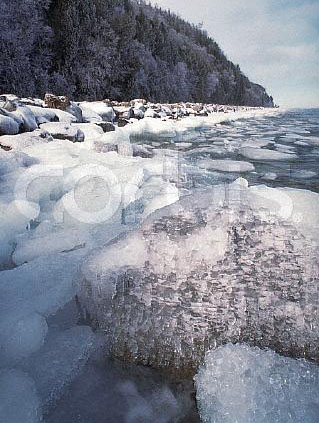
Figure 11 : Ice'd Shoreline
|
Effects of Ice on the Shoreline
Acts as a battering ram against the shoreline
Contraction and expansion through its freezing and thawing.
Freezing to the coast - acts as a cantilever beam, providing enough force to dislodge larger portions of the shoreline
As the ice becomes dislodged from the shore, it can take materials away.
It can also act as a protective agent, where if frozen to the coast, it can act as armoring from storm action.
|
Wave Oscillations

Figure 13 : Deep Water Oscillations
In deep water there is an oscillation of the water particles with no net particle movement forward, yet the potential energy progresses forward. (really there's a very slight preference forward, but most consider it negligible.
Shallowing of Waves - Shoaling
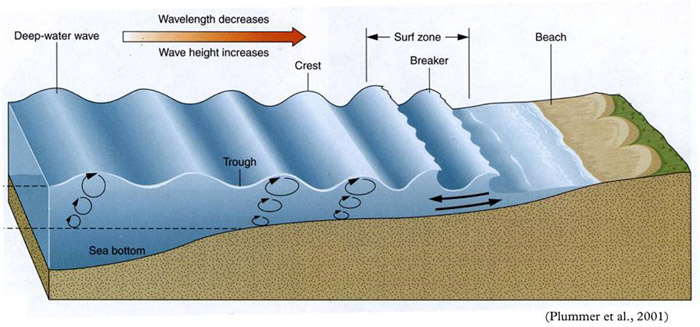
Figure 14 : Shoaling |
As the waves reach shallower water, the lake bottom induces friction, and the circular orbits flatten into ovals. This gradual loss of energy on the lake bottom, reduces the potential for shoreline destruction as the waves lose most their energy before getting to the shoreline.
|

Figure 15 : Curl - Throwing water forward
|
Here is a wave that has reached the shallow water, and has done so abruptly enough to actually propel the water forward at its top.
|
Longshore Currents
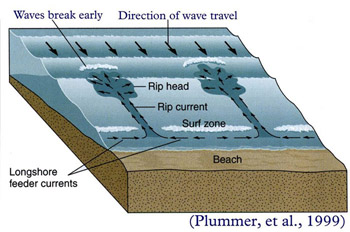
Figure 16 : Longshore Currents
Waves parallel to coast |

Figure 17 : Longshore Currents
Waves coming in at right angles
|
Longshore currents are currents that move along the shore, usually in a specific direction. They are limited in erosive significance but are very important in littoral material movement along a shoreline where they transport large amounts of sediment. They are induced by waves hitting a shore. If the waves are coming in at a 90 degree angle, the longshore currents will be limited. Most littoral drift occurs in shallow water less than 2m deep.
|
|
Refraction waves are caused by the oscillations moving through shallower water on an angle. The shallowing acts as a new medium, and slows the waves down that come to the coast first. This reduces the angle at which the waves hit the shore. The longshore current is propelled to the right in this figure, and can almost be seen as being squeezed out. This is NOT the cause of longshore currents, but can be seen as a reinforcing mechanism.
|
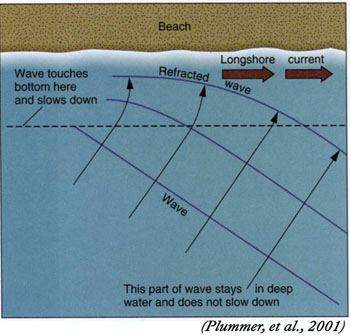
Figure 18 : Refraction Waves
|
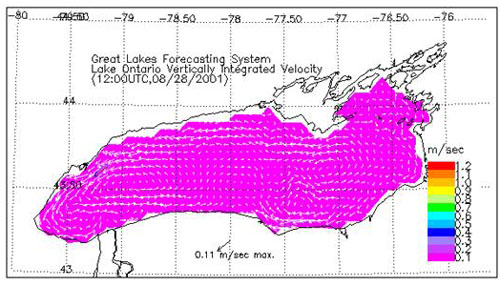
Figure 19 : Lake Ontario Circulation (08/28/2001)
|
Here is a circulation diagram for Lake Ontario that shows the longshore currents moving along the shores. The length of each arrow describes its velocity, and the greatest velocities can be found closest to shore.
|
Scarborough Bluffs
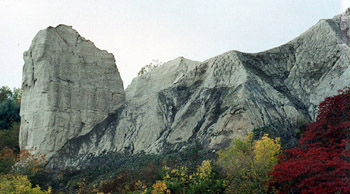
Figure 20 : Scarborough Bluffs | 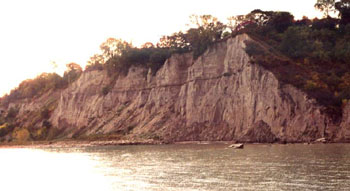
Figure 21 : Scarborough Bluffs
|
The bluffs are made of a weak material composed of glacial sands, silts, well-bedded clays and boulder clay. They are highly susceptible to erosion for many reasons, including their weak structure, lack of plant roots, and their steep slopes. Wind acts as an agent of erosion on the sandy layers, and attack each face. High bluffs will be more susceptible to erosion due to their over steepened slopes and larger surface area for precipitation, wind, and groundwater to attack.
|
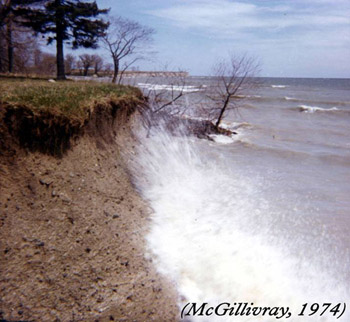
Figure 22 : High Water Levels
Waves Hitting Bluffs |

Figure 23 : Low Water Levels
Water has receded - exposing deeper bluffs
|
Wave action directly on the bluffs can occur when the water levels are high enough. The consequence of this is that the waves can disipate their energy directly on the bluffs, an already weak and frail surface.
|
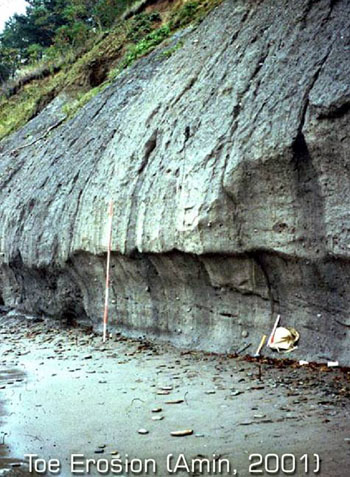
Figure 24 : Toe Erosion (click image to see stages diagram)
|
When the water levels are high enough, the waves can directly hit the bluffs, causing instability due to the undercutting nature. The undercut bank no longer can support the overlying mass, and eventually some of the top of the bluff falls down to the base. If the water level is high, or soon to be high, the newly fallen debris can be carried away from the site. If the water level is low, and remains low for a while, the debris has time to settle and consolidate, and can provide protection to the bluff.
|

Figure 25 : Bluff Defense
By protecting the base, the slope is reduced naturally. This allows plants a surface to establish on, and the plant roots to stabilize the slope. The downside of this protection measure, is now geologists cannot view some important stratigraphic layers in the bluffs, as they have been covered or blended together at the surface.
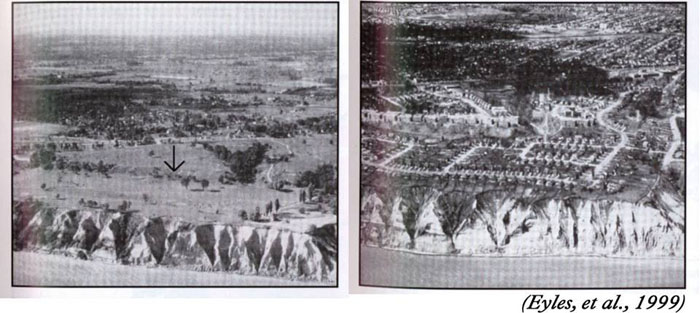
Figure 26 : Bluff Retreat
Should You Build Your House Right Behind The Scarborough Bluffs? (click image to see answer)
|















